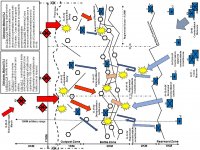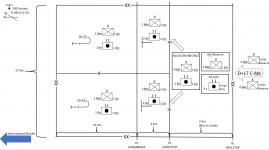I decided that depth and the use of counter attacks at all levels would be the key elements of my solution. We didn't have a lot of information on the enemy but we knew they'd seek a break in which they would then exploit. I figured they would structure their attack with a reconnaissance element (as well as acknowledging the possibility that this could become prolonged and that reconnaissance and things like raids could become a daily feature), followed by a forward security element, and then the main body. I, therefore, structured my defence zones to be capable of dealing with all three of those elements.
This echeloning of my forces also means that my lead elements are the smallest and the most flexible to displace within their zone. This reduces the Div's vulnerability to indirect fire. Looking back on it as this was taking place during the Second World War, the enemy would have been less reliant on predictive fire and perhaps a timed deliberate withdrawal in conjunction with a deception plan would have been required to prevent these lead elements from absorbing a large preparatory barrage.
My depth is likely a little too deep. I should have not gone beyond 10-12 km based on an artillery range of 10 km. The major factor in deciding my depth was artillery range, providing sufficient depth to exhaust the enemy and allow me to determine where the main attack was focused, and my own ability to bring up my own c-atk forces.
Counter attacking was essential. My assumption was that the enemy WILL penetrate my position. I therefore decided that I would defeat the enemy INSIDE my position. Once you decide this, control measures like kill zones lose their relevance at this level and the use of the counter attack becomes the dominant means of defeating the enemy.
Having said that I also realised that the enemy's attack may not look like a large single action, and in fact my goal was to ensure that they weren't able to achieve the momentum to do this throughout my depth. The enemy may have attacked over an extended period, particularly if his initial attack is frustrated, conducting a series of probing attacks using reconnaissance elements and forward security elements. I wanted to be able to defeat these short of the main position. Further, these attacks would take time. Once the enemy stopped I wanted my people to have the freedom, and to understand I expect them to take the initiative, to counter attack while the enemy if vulnerable and re-take anything we might have lost. This would make the battle much more fluid as opposed to the enemy slowly biting chunks off of me over time.
Depth and local counter attacks are meant to increase the enemy's uncertainty and friction, thereby reducing his understanding and his ability to coordinate and concentrate his cbt power. The further he enters the position the less intelligence he'll have and the more resistance he'll encounter. He'll be forced to conduct an advance to contact against prepared positions all the while we continue to receive reporting from bypassed elements. His LoC will become longer and more vulnerable, his sustainment more difficult. Each counter attack introduces surprise and shock into the enemy command. Lastly, I assumed we had limited anti armour capabilities and knew we had no integral tanks. I needed to stretch out the time the enemy would need to get through my defensive zone to ensure I had a cycle of darkness or two to ensure I could counter attack armoured vehicle leaguers with dismounted infantry by night.
Infanteer points out the advantages of arraying in column versus width I chose to go this way as it was most conducive to my focus on counter attacking. It meant I could expect each echelon of command to own it's own battle space and counter attack force. Each zone could be given to a single commander within their respective boundaries. Covering force zone would be a Coy comd, the buffer zone would be that Coy's Bn Comd, the Bde Comd owns the main battle area and each has a counter attack force, with perhaps the exception of the covering force area which would rely on non engaged forces from that parent company. I also stole it from German elastic defence ops in WW 1.
I wanted to ensure that Divs had access to CAS but I thought disrupting the enemy's ability to coordinate their attack and introduce follow on echelons was more important. I thought that air support might give me the ability to engage enemy formations piecemeal and thereby defeat them in detail. I therefore gave the majority of my air support to interdiction.
A lot of this is still pretty conceptual and needs further thought on how it would work with our current system. If I'm only tasking the first Bn to man the Covering Force and the Buffer Zone, what would their tactical task be? Guard? Delay? Perhaps the more general tactical activity of "defend" would be more appropriate? Some older American stuff uses "Defend" vice block, destroy, etc. Is this an area defence or mobile defence? Does it matter? I'm beginning to think the dichotomy maybe false and perhaps even harmful. What happens to the lead Bn once the enemy penetrates into the main battle area? Do I leave them there to limit the width of the enemy penetration? Do I suck them back to make additional reserves? What factors govern this decision? What task do I give them so they understand that they need to plan for these possibilities? All questions I'm thinking about but don't yet have answers for.
This system accepts a much higher level of uncertainty than we're used to today. It doesn't rely on the commander necessarily being able to say "I'm going to kill the enemy here (points at KZ)" and then backwards plan from that. It is derived from a time when positional defence wasn't based on battle positions but actual trench lines. Continuous trench lines across the entire front line and extending in depth. I think this system is sufficiently different to what we practice today, even if it works with our current principals and fundamentals of the defence, that personnel would need training on it prior to execution.




